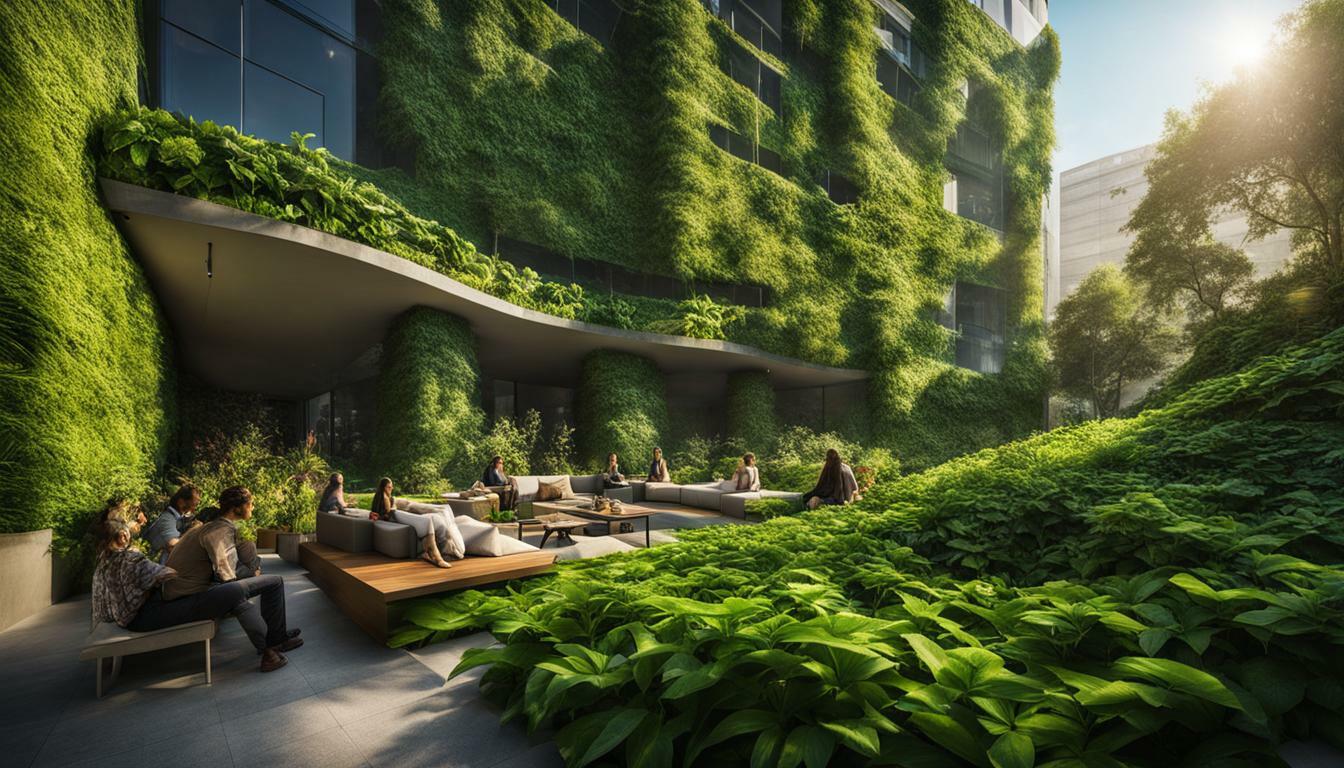Vertical gardens are an innovative and sustainable way to bring nature into our homes, businesses, and cities. They offer numerous benefits, including enhancing aesthetics, improving air quality, maximizing small spaces, and providing a solution for urban dwellers who lack access to green areas.
One of the key advantages of vertical gardens is their ability to enhance aesthetics and improve air quality. Vertical gardens add beauty and life to urban spaces while also filtering out toxins and improving air quality. They create a visually stunning display of greenery, transforming concrete jungles into vibrant and inviting environments.
In addition to their aesthetic appeal, vertical gardens are a space-saving solution for urban areas. By utilizing unused vertical space, urban dwellers can maximize small areas and create beautiful green havens. Whether it’s a balcony, terrace, or indoor wall, vertical gardens provide a way to bring nature into even the smallest spaces.
There are different types of vertical gardens to suit various needs and preferences. These include hydroponic systems, wall gardens, and hanging gardens. Each type offers unique advantages and allows for the growth of a wide variety of plants.
To create a vertical garden, certain supplies are needed. These include frameworks, plants, soil, and irrigation systems. Proper preparation of the soil is crucial for successful vertical gardening. The soil should be well-drained, nutrient-rich, and slightly acidic. Incorporating organic matter like compost and composted manure can provide essential nutrients and improve drainage.
Once the soil is prepared, planting and maintaining the vertical garden requires attention to watering, fertilizing, and regular care. Choosing the right combination of plants is also important for a thriving vertical garden. Factors such as sunlight and maintenance requirements should be considered when selecting and combining plants.
Choosing the ideal location for a vertical garden is another important consideration. The location should provide adequate sunlight exposure and available space for the vertical garden to thrive. Proper placement will ensure the plants receive the necessary sunlight and environment for optimal growth.
Vertical gardens also offer energy conservation benefits. They can help reduce the urban heat island effect and improve building insulation. By absorbing heat and cooling the air around them, vertical gardens contribute to energy efficiency and provide relief from the sweltering heat in urban areas.
In conclusion, vertical gardens offer numerous benefits for urban living spaces. They enhance aesthetics, improve air quality, maximize small spaces, and contribute to energy conservation. Embracing this sustainable gardening trend allows urban dwellers to bring nature into their surroundings and enjoy the numerous advantages of vertical gardens.
Key Takeaways:
- Vertical gardens enhance aesthetics and improve air quality in urban areas.
- They maximize small spaces and provide a space-saving solution for urban dwellers.
- There are different types of vertical gardens, including hydroponic systems, wall gardens, and hanging gardens.
- Supplies needed for vertical gardens include frameworks, plants, soil, and irrigation systems.
- Proper soil preparation is essential for successful vertical gardening.
- Planting and maintaining a vertical garden require attention to watering, fertilizing, and regular care.
- Choosing the right combination of plants is important for a thriving vertical garden.
- Selecting the ideal location with adequate sunlight exposure is essential for vertical garden success.
- Vertical gardens contribute to energy conservation by reducing the urban heat island effect and improving building insulation.
Enhance Aesthetics and Improve Air Quality
Vertical gardens not only bring beauty and life to the area, but they also provide multiple benefits in terms of air quality and aesthetics. By utilizing vertical space, these gardens can transform urban environments into vibrant green spaces, enhancing the overall aesthetics of the surroundings.
One of the key advantages of vertical gardens is their ability to improve air quality. Plants naturally filter out toxins and pollutants from the air, helping to create a cleaner and healthier environment. The vertical arrangement of plants allows for greater air circulation, allowing the plants to effectively absorb pollutants and release fresh oxygen.
Studies have shown that vertical gardens can significantly reduce air pollution levels in urban areas, making them an effective solution for combating the negative effects of pollution on human health. By incorporating vertical gardens into urban spaces, we can create healthier and more sustainable environments for everyone.
| Benefits of Vertical Gardens for Enhancing Aesthetics and Improving Air Quality: |
|---|
| Enhance the beauty of urban spaces |
| Improve air quality by filtering out toxins |
“Vertical gardens not only bring beauty and life to the area, but they also provide multiple benefits in terms of air quality, energy savings, and noise reduction.”
The Benefits of Green Walls
Green walls, also known as living walls or vertical gardens, are a popular choice for enhancing aesthetics and improving air quality in urban spaces. These walls are composed of a variety of plants that are arranged vertically on a structure or wall, creating a visually striking and eco-friendly display.
Green walls not only add a touch of natural beauty to urban areas but also have several environmental benefits. By absorbing carbon dioxide and releasing oxygen, they help to reduce air pollution and combat the urban heat island effect. The plants in green walls also act as a natural sound barrier, reducing noise pollution and creating a more peaceful environment.
The installation of green walls is a sustainable and innovative way to transform ordinary walls into living, breathing works of art. Whether used in commercial buildings, residential complexes, or public spaces, green walls provide a multitude of benefits for both the environment and the people who interact with them.
- Enhance the beauty of urban spaces
- Improve air quality by filtering out toxins
- Reduce air pollution and combat the urban heat island effect
- Act as a natural sound barrier, reducing noise pollution
With their ability to enhance aesthetics and improve air quality, vertical gardens and green walls are becoming increasingly popular in urban living spaces. These innovative and sustainable solutions not only bring nature into our concrete jungles but also create healthier and more vibrant environments for us to thrive in.
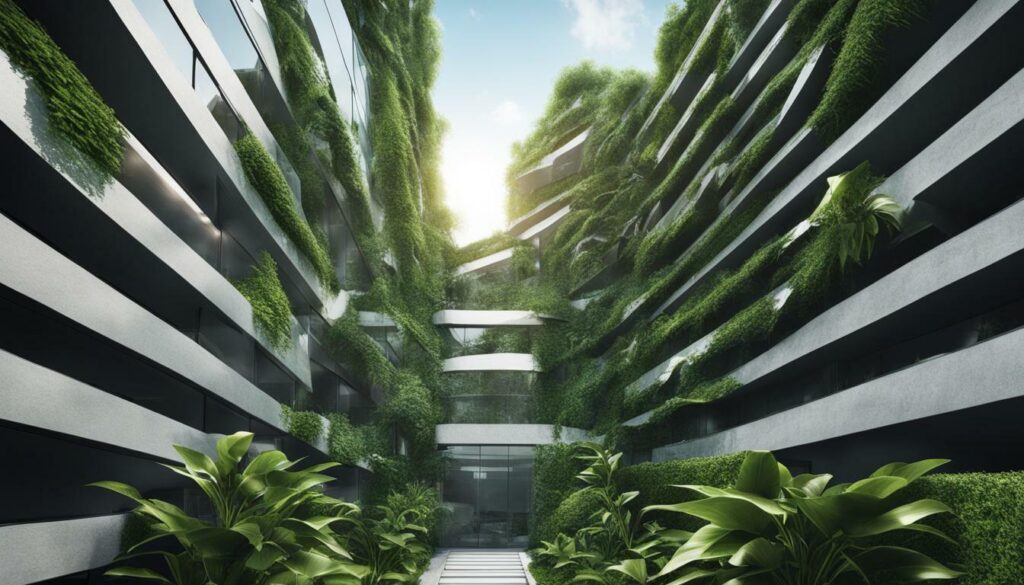
Maximize Small Spaces in Urban Areas
By utilizing vertical space, vertical gardens can save space and provide many additional benefits in urban areas. Vertical gardens are an innovative and sustainable way to bring nature into our homes, businesses, and cities. They are popularly used to bring greenery into urban spaces that do not have access to traditional gardens or green areas, as well as to enhance and beautify existing green spaces.
One of the main advantages of vertical gardens is their ability to maximize small spaces. In densely populated urban areas where ground space is limited, vertical gardens offer a solution to make the most out of unused vertical surfaces. By growing plants vertically, you can transform walls, fences, balconies, and rooftops into lush green spaces.
Vertical gardens not only provide aesthetic value but also offer multiple benefits. They improve air quality by absorbing pollutants and releasing oxygen, creating a healthier environment for urban dwellers. These green walls act as natural filters, removing toxins and improving the overall air quality.
In addition, vertical gardens help to regulate temperature and mitigate the urban heat island effect, which is the phenomenon of urban areas being significantly hotter than surrounding rural areas. The plants in vertical gardens absorb heat and reduce temperatures, making urban spaces more comfortable and energy-efficient.
| Benefits of Vertical Gardens in Urban Areas: |
|---|
| Maximize small spaces |
| Improve air quality |
| Regulate temperature and reduce urban heat island effect |
| Enhance aesthetics of urban areas |
| Provide habitats for biodiversity |
Vertical gardens offer a multitude of benefits for urban areas, making them an ideal choice for those looking to bring nature into small and confined spaces. With the right selection of plants, proper maintenance, and thoughtful design, vertical gardens can transform urban landscapes into thriving green oases.
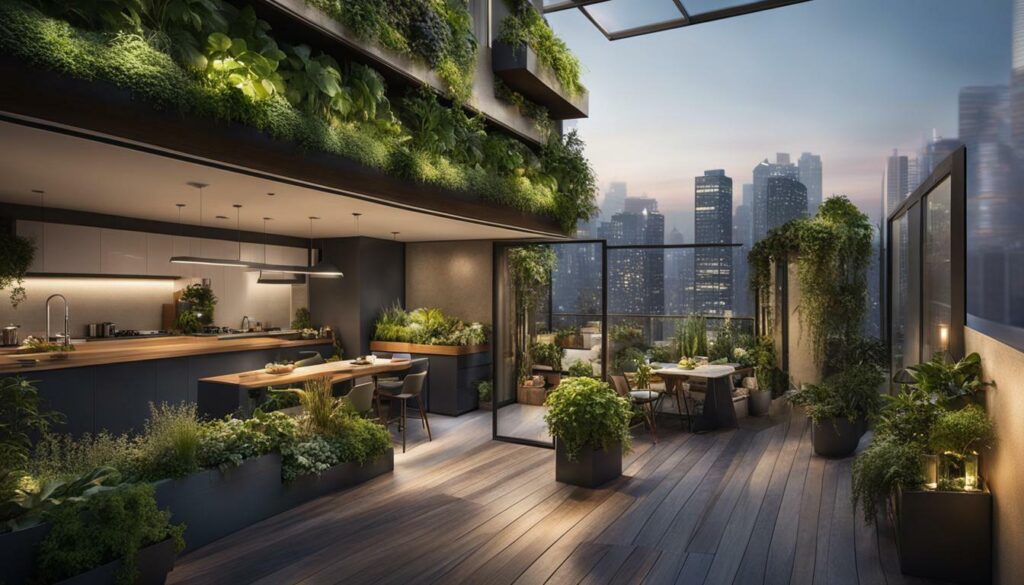
Different Types of Vertical Gardens
Vertical gardens are an incredibly versatile way to bring nature into your home or office, with several types to choose from. Whether you have limited space or simply want to add a touch of greenery to your surroundings, there is a vertical garden option that can meet your needs. Let’s explore some of the most popular types of vertical gardens:
1. Green walls
Green walls, also known as living walls or vertical greenery systems, are a popular choice for both indoor and outdoor spaces. These gardens are created by attaching plants to a vertical structure, such as a wall or fence. Green walls can be tailored to suit any aesthetic, with various plant species and arrangements available. They not only provide visual interest but also help to improve air quality and regulate temperature.
2. Tiered gardens
Tiered gardens consist of multiple levels or tiers, each with its own planting area. This design allows for a larger number of plants to be grown in a compact space. Tiered gardens are particularly suitable for balconies or small outdoor areas where horizontal space is limited. They can be created using shelves, plant stands, or even repurposed materials like wooden pallets.
3. Trellises
Trellises are vertical structures that provide support for climbing plants. They are commonly used in gardens to create vertical growing spaces and add height to an outdoor area. Trellises can be made from materials such as wood, metal, or bamboo, and can be customized to suit your preferences. They are an excellent option for growing vining plants like cucumbers, grapes, or flowering vines.
4. Green facades
Green facades, also known as living facades or vertical greening systems, are similar to green walls but are specifically designed to cover the exterior of buildings. These gardens not only enhance the visual appeal of a building but also provide insulation and cooling effects, helping to reduce energy consumption. Green facades can be created using a variety of plants, including climbing vines and cascading flora.
5. Hanging gardens
Hanging gardens are an excellent choice for those with limited floor space or who want to create an eye-catching display in their outdoor areas. These gardens involve suspending plants from an overhead structure, such as a pergola or hanging baskets. Hanging gardens can be easily customized with a variety of plant species, allowing for a stunning vertical arrangement.
Each type of vertical garden offers its own unique advantages, allowing you to create a customized green space that suits your style and needs. Whether you prefer a lush green wall, a tiered garden full of colorful blooms, or a cascading green facade, there is a vertical garden option that can transform your space into a thriving oasis.
| Type of Vertical Garden | Main Features |
|---|---|
| Green walls | Attach plants to a vertical structure, improve air quality |
| Tiered gardens | Multiple levels for compact growing, suitable for small spaces |
| Trellises | Provide support for climbing plants, add height to outdoor areas |
| Green facades | Exterior building covering, enhance insulation and cooling effects |
| Hanging gardens | Suspend plants from overhead structures, create eye-catching displays |
Supplies Needed for Vertical Gardens
To create a vertical garden, you will need a few supplies, including a framework, the right plants, soil, and a watering system. These essential tools and materials are key to building a thriving vertical garden that will bring beauty and nature into your urban living space.
First and foremost, you’ll need a framework to support your vertical garden. This could be a wall, a trellis, or even a standalone structure. The framework provides the structure and stability for your plants to grow vertically and allows you to maximize your vertical space.
Table 1: Supplies Needed for Vertical Gardens
| Supplies | Description |
|---|---|
| Framework | Support structure for the vertical garden |
| Plants | Variety of plants suitable for vertical growth |
| Soil | Nutrient-rich soil suitable for vertical gardens |
| Watering System | Irrigation system or watering tools to ensure proper hydration |
Next, you’ll need to select the right plants for your vertical garden. Choose plants that are suitable for vertical growth and can thrive in your specific environment. Consider factors such as sunlight exposure, temperature, and maintenance requirements when selecting your plants.
Proper soil is crucial for the success of your vertical garden. Use a nutrient-rich soil that provides the necessary support and nourishment for your plants. Consider adding organic matter such as compost or composted manure to improve soil fertility and drainage.
Lastly, you’ll need a reliable watering system to ensure your vertical garden is adequately hydrated. This can be an irrigation system with drip lines or a hose with a timer. A consistent and efficient watering system is essential to keep your plants healthy and thriving.
With these supplies in hand, you’ll be well-equipped to create your very own vertical garden. Remember to follow best practices for planting, maintaining, and combining plants to ensure the success of your vertical garden.
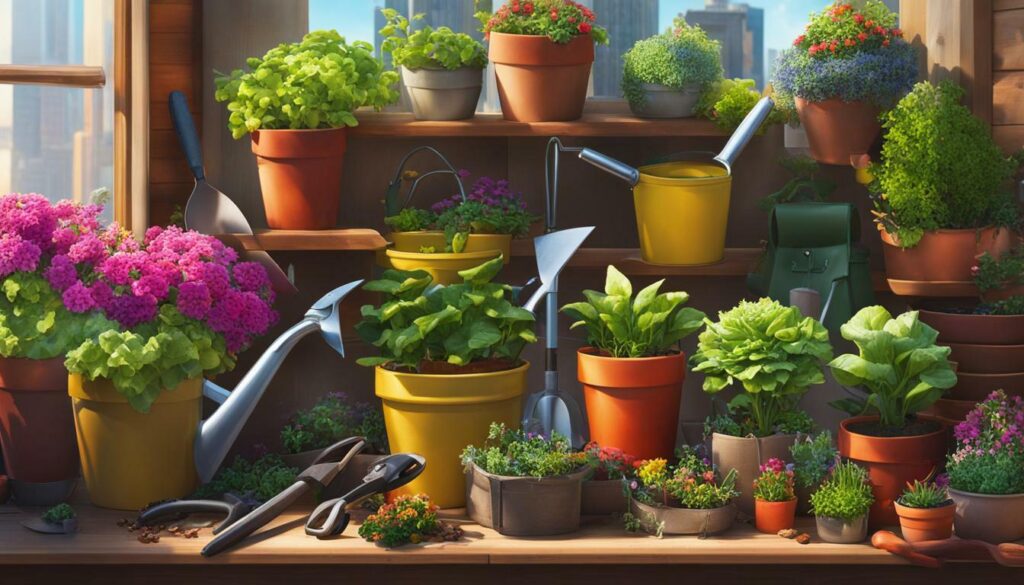
Preparing the Soil for a Vertical Garden
Preparing the soil for a vertical garden is an essential step in achieving a successful outcome. The soil should be well-drained and nutrient-rich, with a slightly acidic pH balance of around 6.5. A soil test is recommended to ensure the ideal balance of microorganisms and macro-nutrients.
Organic matter like compost and composted manure should be incorporated into the soil to provide a source of nutrients and improve drainage. Also, it is important to note that the soil should be slightly looser than normal to avoid compaction.

Creating the ideal conditions for your vertical garden to thrive isn’t just a matter of luck; it takes time and effort to properly prepare the soil. Tilling and amending the soil with nutrients such as fertilizer and compost can give your vertical garden the best possible foundation for success.
| Key Steps for Preparing Soil for a Vertical Garden |
|---|
| 1. Test the soil to determine pH and nutrient levels. |
| 2. Incorporate organic matter like compost and composted manure. |
| 3. Ensure the soil is well-drained and slightly loose to avoid compaction. |
| 4. Consider using fertilizers and soil amendments to provide essential nutrients. |
| 5. Regularly monitor soil moisture and adjust watering as needed. |
Carefully and thoughtfully prepare the soil for a vertical garden to ensure that your plants will have all the sustenance they need to truly flourish. From providing the essential nutrients and minerals to ensuring adequate drainage and aeration, there is nothing more important than giving your vertical garden the foundation it needs to reach its full potential.
Planting and Maintaining a Vertical Garden
Planting and maintaining a vertical garden is a great way to save space and make the most of your green thumb. Vertical gardens utilize the unused vertical space in urban areas, allowing you to grow a variety of plants even in limited space. Whether you have a small balcony, a wall, or a trellis, vertical gardens offer a creative and efficient solution for urban gardening.
One of the key benefits of vertical gardens is their ability to maximize small spaces. By growing plants vertically, you can make use of walls, fences, or other structures to create a vibrant garden without taking up valuable floor space. This is particularly advantageous for urban dwellers who may have limited outdoor areas. With a vertical garden, you can enjoy the beauty of nature and reap the rewards of gardening even in a small apartment or office.
To create a successful vertical garden, it is important to choose the right plants and provide proper care and maintenance. Select plants that are suitable for vertical growth and consider their sunlight and water requirements. It is also important to ensure the soil is well-drained and nutrient-rich to support healthy plant growth. Regular watering, fertilizing, and pruning are essential for maintaining the health and beauty of your vertical garden.
Creating a vertical garden involves selecting the right supplies and setting up the necessary infrastructure. From frameworks and pots to irrigation systems and fertilizers, there are various supplies needed to create a thriving vertical garden. It is important to choose high-quality materials that are suitable for your specific garden design and plant selection.
| Supplies Needed for Vertical Gardens |
|---|
| Framework or structure |
| Plants |
| Soil or growing medium |
| Irrigation system |
| Fertilizer |
| Pruning tools |
| Support structures (trellis, hooks, etc.) |
Proper soil preparation is crucial for the success of your vertical garden. Before planting, ensure that the soil is well-drained and enriched with organic matter. Incorporating compost and composted manure can improve the soil’s fertility and drainage. It is also important to test the soil pH and adjust it if necessary for optimal plant growth. Taking the time to prepare the soil properly will provide a solid foundation for your plants to thrive.
Once your vertical garden is set up and the soil is prepared, it’s time to plant and maintain your garden. Follow the specific planting instructions for each plant, considering factors such as spacing, depth, and sunlight requirements. Regularly water and fertilize your plants to ensure they receive the necessary nutrients for healthy growth. Additionally, monitor for pests and diseases, and take appropriate measures to protect your plants.
Planting and Maintaining a Vertical Garden: Tips and Considerations
- Choose plants that are suitable for vertical growth and consider their sunlight and water requirements.
- Ensure the soil is well-drained and nutrient-rich for optimal plant growth.
- Regularly water and fertilize your plants to provide them with essential nutrients.
- Monitor for pests and diseases and take appropriate measures to protect your plants.
- Prune and trim your plants as needed to promote healthy growth and maintain the desired shape and appearance of your vertical garden.
By following these tips and guidelines, you can create and maintain a thriving vertical garden that brings beauty and nature into your urban living space.
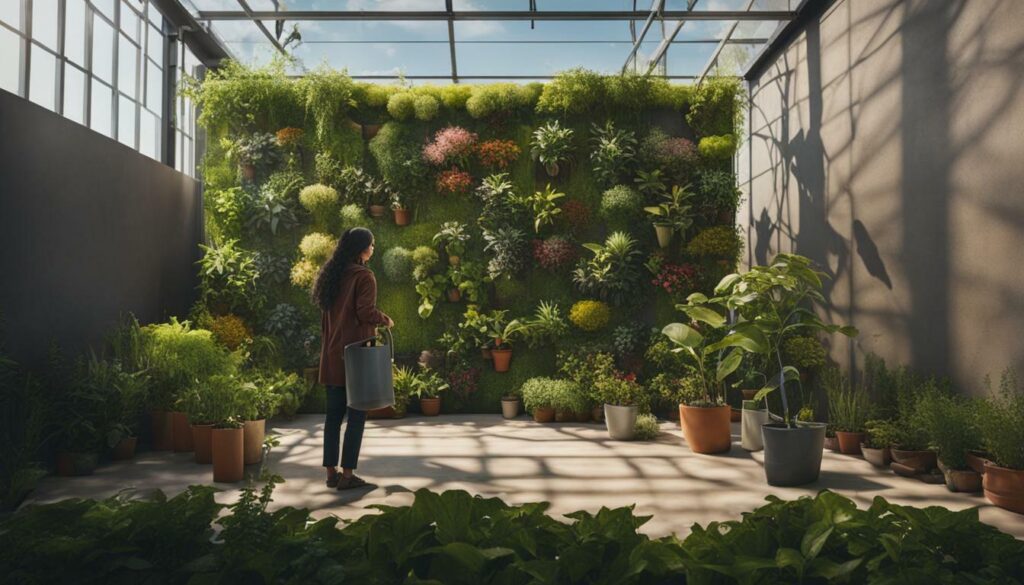
Combining Plants for a Successful Vertical Garden
Combining plants for a successful vertical garden is a great way to add variety and beauty to your space. Whether you are creating a green wall, a tiered garden, or a hanging garden, carefully selecting and pairing plants is essential for achieving a thriving vertical garden. By considering factors such as sunlight exposure, growth habit, and maintenance requirements, you can create a stunning display of foliage and blooms that will enhance the aesthetics of your urban living space.
When choosing plants for your vertical garden, it is important to consider their compatibility in terms of light requirements and growth habits. Some plants thrive in full sunlight, while others prefer shade or partial shade. By grouping plants with similar light needs together, you can ensure that each plant receives the proper amount of sunlight for healthy growth.
In addition to light requirements, consider the growth habits of the plants you choose. Some plants, such as trailing vines or cascading flowers, are perfect for creating a cascading effect down the vertical structure. Others, such as upright flowering plants or foliage plants, add height and structure to the garden. By combining plants with different growth habits, you can create a visually appealing and dynamic vertical garden.
Here is a table summarizing some popular plants for vertical gardens:
| Plant | Light Requirements | Growth Habit |
|---|---|---|
| English Ivy | Full Shade to Sun | Trailing Vine |
| Spider Plant | Medium to Bright Indirect Light | Upright Foliage |
| Petunia | Full Sun | Trailing Flower |
| Dracaena | Bright Indirect Light | Upright Foliage |
Remember to consider the specific needs of the plants you choose, such as watering and fertilizing requirements. Proper care and maintenance are crucial for the success of your vertical garden. Regularly inspect the plants for signs of pests or diseases and take appropriate measures to prevent or treat them.
By combining plants that complement each other in terms of light requirements, growth habits, and maintenance needs, you can create a successful and visually stunning vertical garden. Experiment with different plant combinations and embrace your creativity to design a unique and beautiful green space in your urban living area.
Choosing the Ideal Location for a Vertical Garden
Choosing the ideal location for a vertical garden is crucial for its success and growth. Whether you are planning to create a vertical garden in your home, office, or outdoor space, there are several factors to consider to ensure optimum growing conditions for your plants.
First and foremost, assess the amount of sunlight the location receives. Most plants require at least six hours of direct sunlight each day to thrive. Observe the area throughout the day and take note of any shade or shadows cast by nearby buildings or trees. This will help you determine if the spot you have in mind is suitable for the plants you wish to grow.
Additionally, consider the available space and accessibility for maintenance. Ensure that the vertical garden will not obstruct walkways or impede movement in the area. If space is limited, vertical gardens offer a space-saving solution, allowing you to make the most of unused vertical space.
Furthermore, think about the water source and irrigation system. Vertical gardens require regular watering to keep the plants healthy. Ensure that the location is easily accessible to a water source, whether it be a hose, watering can, or an automated irrigation system.
Table 1: Ideal Plants for Different Sunlight Conditions
| Amount of Sunlight | Ideal Plants |
|---|---|
| Full Sun (6+ hours) | Sunflowers, Tomatoes, Herbs (Rosemary, Basil, Thyme) |
| Partial Sun (4-6 hours) | Leafy Greens (Lettuce, Spinach), Pansies, Begonias |
| Shade (Less than 4 hours) | Ferns, Hostas, Impatiens |
In summary, choose a location for your vertical garden that receives sufficient sunlight, has enough space for growth and maintenance, and is easily accessible to a water source. By considering these factors, you can create an optimal environment for your vertical garden and enjoy the beauty and benefits of growing plants vertically.
Utilizing Vertical Gardens to Conserve Energy
Vertical gardens are not only aesthetically pleasing but also contribute to conserving energy in urban areas. These innovative gardens have the potential to provide numerous benefits, including reducing the urban heat island effect, improving building insulation, and promoting a more sustainable environment.
One of the key ways that vertical gardens conserve energy is by helping to mitigate the urban heat island effect. This phenomenon occurs when urban areas experience significantly higher temperatures than surrounding rural areas. The use of concrete, asphalt, and other heat-absorbing materials in cities contributes to this effect. Vertical gardens, with their lush vegetation and greenery, can help to counteract this by providing shade and evaporative cooling. The plants in the vertical garden absorb heat and release moisture through transpiration, which cools the surrounding air. This natural cooling effect can help to reduce the need for artificial cooling systems, thus saving energy and reducing greenhouse gas emissions.
Vertical gardens also enhance building insulation, particularly when installed on exterior walls. The layer of vegetation acts as a natural insulator, reducing heat transfer between the outside and inside of the building. This can help to regulate indoor temperatures, reducing the need for heating and cooling systems and saving energy in the process. Additionally, vertical gardens can provide thermal mass, which helps to stabilize indoor temperatures by absorbing excess heat during the day and releasing it at night. This further reduces the energy required for heating and cooling.
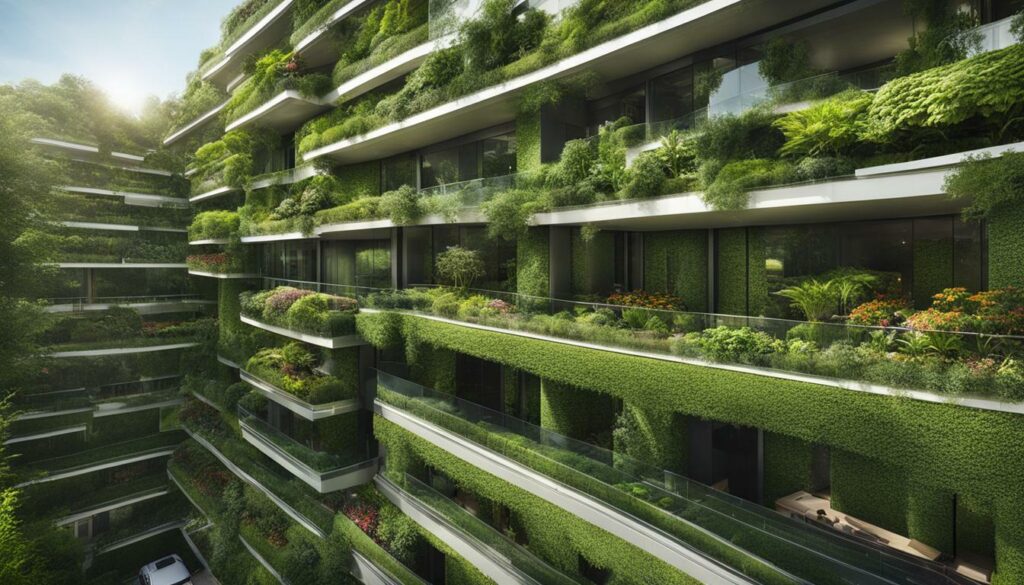
The table below summarizes the energy-saving benefits of vertical gardens:
| Energy Saving Benefits of Vertical Gardens |
|---|
| – Reduces the urban heat island effect |
| – Improves building insulation |
| – Provides shade and evaporative cooling |
| – Regulates indoor temperatures |
| – Reduces the need for artificial cooling systems |
| – Saves energy and reduces greenhouse gas emissions |
Vertical gardens not only offer visual beauty and greenery in urban areas but also have the potential to significantly contribute to energy conservation. By harnessing the natural cooling and insulating properties of plants, these gardens can help create more sustainable and energy-efficient cities. Incorporating vertical gardens into urban design and architecture is a step towards a greener future.
Conclusion
Vertical gardens are one of the best ways to bring nature into urban spaces, offering a range of benefits and enhancing the overall quality of life. By utilizing vertical space, these gardens allow individuals to create stunning works of living art, thriving with a variety of plants. Not only do they add beauty and aesthetic appeal to homes and neighborhoods, but they also contribute to a healthier environment and provide numerous advantages.
One of the key benefits of vertical gardens is their ability to combat urban sprawl. By making use of unused walls, rooftops, and other vertical surfaces, these gardens maximize space utilization without compromising on plant growth. This is particularly important in densely populated areas where green spaces are limited. Vertical gardens not only add a touch of greenery to the concrete jungle but also help to offset the negative impact of urbanization on nature.
Moreover, vertical gardens have a positive impact on the environment. They serve as effective carbon sinks, absorbing carbon dioxide and releasing oxygen into the air. This contributes to cleaner and fresher air quality in urban areas, helping to reduce air pollution. Additionally, vertical gardens can help to combat the urban heat island effect by providing shade and cooling the surrounding areas. This not only makes the environment more comfortable for residents but also reduces the energy consumption needed for cooling buildings.
Furthermore, vertical gardens offer a sustainable food source option. By incorporating edible plants in these gardens, individuals can grow their own vegetables, herbs, and fruits, even in limited spaces. The vertical structure allows for better sunlight exposure and air circulation, resulting in healthier and more abundant harvests. This promotes self-sufficiency and encourages sustainable living practices.
In conclusion, vertical gardens are a versatile and sustainable solution for urban dwellers who want to bring nature into their living spaces. With their ability to maximize space, combat urban sprawl, improve air quality, provide a sustainable food source, and enhance the overall aesthetics of urban areas, vertical gardens offer a multitude of benefits. By embracing this gardening trend, individuals can create a greener and more beautiful urban environment while enjoying the many advantages that vertical gardens have to offer.
What are the benefits of using premium vertical garden stands in urban living spaces?
Premium vertical garden stands offer an efficient and visually appealing way to incorporate greenery into urban living spaces. These stands can save space, improve air quality, and provide a soothing environment. With their high-quality materials and design, premium vertical garden stands elevate the overall aesthetic of any urban setting.
FAQ
Q: What are the benefits of vertical gardens in urban living spaces?
A: Vertical gardens enhance the aesthetics of urban spaces, improve air quality by filtering out toxins, maximize small spaces, provide a range of design options, and contribute to energy conservation.
Q: What types of vertical gardens are available?
A: There are several types of vertical gardens, including hydroponic systems, wall gardens, and hanging gardens.
Q: What supplies are needed to create a vertical garden?
A: To create a vertical garden, you will need a framework, plants, soil, and an irrigation system.
Q: How should I prepare the soil for a vertical garden?
A: It is important to ensure that the soil is well-drained, nutrient-rich, and slightly acidic. Incorporating organic matter like compost and composted manure can improve drainage and provide nutrients.
Q: How do I plant and maintain a vertical garden?
A: Planting and maintaining a vertical garden involves proper watering, fertilizing, and regular care. Selecting the right plants and providing necessary support is also essential.
Q: How can I combine plants for a successful vertical garden?
A: When selecting plants for a vertical garden, consider factors such as sunlight exposure and maintenance requirements. Choose plants with different shapes, sizes, and colors to create an aesthetically pleasing and thriving garden.
Q: How do I choose the ideal location for a vertical garden?
A: Select a location for your vertical garden that receives adequate sunlight and has sufficient space. Consider factors such as the size of the plants and the available vertical surface area.
Q: Can vertical gardens help conserve energy?
A: Yes, vertical gardens can contribute to energy conservation by reducing the urban heat island effect and improving building insulation.

